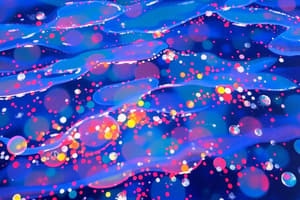Podcast
Questions and Answers
What type of data do Ocean Colour Monitors (OCMs) primarily collect?
What type of data do Ocean Colour Monitors (OCMs) primarily collect?
- Intensity of light reflected from the ocean (correct)
- Temperature gradients at different ocean depths
- Sound waves emitted by marine life
- Salinity levels in coastal regions
Which substance's concentration can be determined using data from Ocean Colour Monitors?
Which substance's concentration can be determined using data from Ocean Colour Monitors?
- Carbon Monoxide
- Radon
- Chlorophyll (correct)
- Methane
Which of the following is NOT a typical application of OCM data?
Which of the following is NOT a typical application of OCM data?
- Fisheries management
- Monitoring water quality
- Studying phytoplankton blooms
- Tracking air pollution levels (correct)
Which country launched the IRS-P4 satellite carrying an Ocean Colour Monitor?
Which country launched the IRS-P4 satellite carrying an Ocean Colour Monitor?
What does OCM stand for in the context of modifying reflective properties of optical components?
What does OCM stand for in the context of modifying reflective properties of optical components?
What is the primary component in phytoplankton that influences ocean color?
What is the primary component in phytoplankton that influences ocean color?
Which color does chlorophyll mostly reflect?
Which color does chlorophyll mostly reflect?
What might increased sediment levels in ocean water indicate?
What might increased sediment levels in ocean water indicate?
What color does dissolved organic matter tend to make ocean water?
What color does dissolved organic matter tend to make ocean water?
What is one potential use for satellites equipped with ocean color sensors?
What is one potential use for satellites equipped with ocean color sensors?
Flashcards
What is an Ocean Colour Monitor (OCM)?
What is an Ocean Colour Monitor (OCM)?
A sensor that measures reflected light intensity from the ocean in different spectral bands.
What are the applications of OCM data?
What are the applications of OCM data?
Monitoring water quality, studying phytoplankton blooms, tracking ocean currents, fisheries management, and climate change research.
Examples of Satellites carrying OCMs?
Examples of Satellites carrying OCMs?
IRS-P4 and Oceansat-2 (both Indian satellites).
What are Optical Coating Materials (OCM)?
What are Optical Coating Materials (OCM)?
Signup and view all the flashcards
What is Organizational Change Management (OCM)?
What is Organizational Change Management (OCM)?
Signup and view all the flashcards
What primarily determines ocean color?
What primarily determines ocean color?
Signup and view all the flashcards
What are phytoplankton?
What are phytoplankton?
Signup and view all the flashcards
How does chlorophyll affect light?
How does chlorophyll affect light?
Signup and view all the flashcards
How do sediments affect ocean color?
How do sediments affect ocean color?
Signup and view all the flashcards
How does dissolved organic matter affect ocean color?
How does dissolved organic matter affect ocean color?
Signup and view all the flashcards
Study Notes
- Ocm may refer to different things depending on the context. Without additional information, it's impossible to provide specific study notes. Possible meanings and associated general information are described below.
Ocean Colour Monitor (OCM)
- OCM is an ocean color sensor.
- It measures the intensity of light reflected from the ocean in several different spectral bands.
- It provides information about the concentration of various substances in the water, such as chlorophyll, sediments, and dissolved organic matter.
- Data from OCMs are used in a variety of applications.
- These applications include monitoring water quality, studying phytoplankton blooms, and tracking ocean currents.
- OCM data can also aid in fisheries management and climate change research.
- Satellites carrying OCMs include: IRS-P4 (India), and Oceansat-2 (India).
Other possible meanings
- Optical Coating Materials (OCM): Materials used to create thin layers on optical components to modify their reflective or transmissive properties.
- Oxidation catalytic mechanisms (OCM): Chemical processes involved in oxidation reactions using catalysts.
- Organizational Change Management (OCM): A framework for managing the effect of new business processes, changes in organizational structure or cultural changes within an enterprise.
General notes on Ocean Colour
- Ocean color is primarily determined by how sunlight interacts with substances present in the water.
- Phytoplankton, microscopic marine plants, contain chlorophyll, which absorbs blue and red light and reflects green light.
- This gives ocean water a green hue when phytoplankton concentrations are high.
- Other substances, such as sediments and dissolved organic matter, can also affect ocean color.
- Sediments reflect light across the spectrum, making the water appear brownish or yellow.
- Dissolved organic matter absorbs blue light and reflects yellow and green light, resulting in a yellow or brown color.
- Changes in ocean color can indicate important changes in the marine environment.
- For example, an increase in chlorophyll concentration may indicate a phytoplankton bloom.
- Increased sediment levels may indicate erosion or runoff from land.
- Satellites equipped with ocean color sensors provide a valuable tool for monitoring the health of the ocean.
Studying That Suits You
Use AI to generate personalized quizzes and flashcards to suit your learning preferences.




